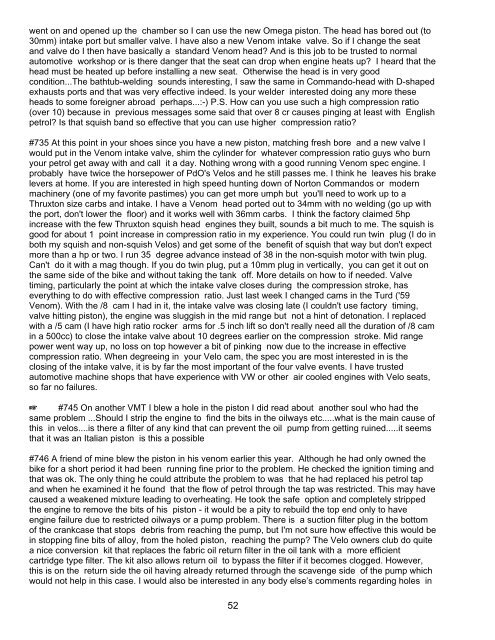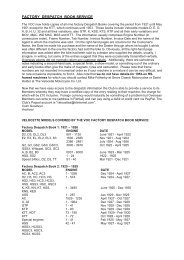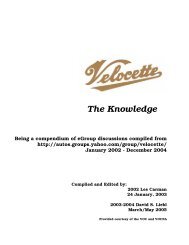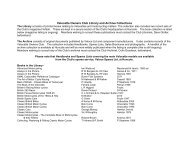The Knowledge - Velocette Owners Club
The Knowledge - Velocette Owners Club
The Knowledge - Velocette Owners Club
Create successful ePaper yourself
Turn your PDF publications into a flip-book with our unique Google optimized e-Paper software.
went on and opened up the chamber so I can use the new Omega piston. <strong>The</strong> head has bored out (to<br />
30mm) intake port but smaller valve. I have also a new Venom intake valve. So if I change the seat<br />
and valve do I then have basically a standard Venom head? And is this job to be trusted to normal<br />
automotive workshop or is there danger that the seat can drop when engine heats up? I heard that the<br />
head must be heated up before installing a new seat. Otherwise the head is in very good<br />
condition...<strong>The</strong> bathtub-welding sounds interesting, I saw the same in Commando-head with D-shaped<br />
exhausts ports and that was very effective indeed. Is your welder interested doing any more these<br />
heads to some foreigner abroad perhaps...:-) P.S. How can you use such a high compression ratio<br />
(over 10) because in previous messages some said that over 8 cr causes pinging at least with English<br />
petrol? Is that squish band so effective that you can use higher compression ratio?<br />
#735 At this point in your shoes since you have a new piston, matching fresh bore and a new valve I<br />
would put in the Venom intake valve, shim the cylinder for whatever compression ratio guys who burn<br />
your petrol get away with and call it a day. Nothing wrong with a good running Venom spec engine. I<br />
probably have twice the horsepower of PdO's Velos and he still passes me. I think he leaves his brake<br />
levers at home. If you are interested in high speed hunting down of Norton Commandos or modern<br />
machinery (one of my favorite pastimes) you can get more umph but you'll need to work up to a<br />
Thruxton size carbs and intake. I have a Venom head ported out to 34mm with no welding (go up with<br />
the port, don't lower the floor) and it works well with 36mm carbs. I think the factory claimed 5hp<br />
increase with the few Thruxton squish head engines they built, sounds a bit much to me. <strong>The</strong> squish is<br />
good for about 1 point increase in compression ratio in my experience. You could run twin plug (I do in<br />
both my squish and non-squish Velos) and get some of the benefit of squish that way but don't expect<br />
more than a hp or two. I run 35 degree advance instead of 38 in the non-squish motor with twin plug.<br />
Can't do it with a mag though. If you do twin plug, put a 10mm plug in vertically, you can get it out on<br />
the same side of the bike and without taking the tank off. More details on how to if needed. Valve<br />
timing, particularly the point at which the intake valve closes during the compression stroke, has<br />
everything to do with effective compression ratio. Just last week I changed cams in the Turd ('59<br />
Venom). With the /8 cam I had in it, the intake valve was closing late (I couldn't use factory timing,<br />
valve hitting piston), the engine was sluggish in the mid range but not a hint of detonation. I replaced<br />
with a /5 cam (I have high ratio rocker arms for .5 inch lift so don't really need all the duration of /8 cam<br />
in a 500cc) to close the intake valve about 10 degrees earlier on the compression stroke. Mid range<br />
power went way up, no loss on top however a bit of pinking now due to the increase in effective<br />
compression ratio. When degreeing in your Velo cam, the spec you are most interested in is the<br />
closing of the intake valve, it is by far the most important of the four valve events. I have trusted<br />
automotive machine shops that have experience with VW or other air cooled engines with Velo seats,<br />
so far no failures.<br />
L #745 On another VMT I blew a hole in the piston I did read about another soul who had the<br />
same problem ...Should I strip the engine to find the bits in the oilways etc.....what is the main cause of<br />
this in velos....is there a filter of any kind that can prevent the oil pump from getting ruined.....it seems<br />
that it was an Italian piston is this a possible<br />
#746 A friend of mine blew the piston in his venom earlier this year. Although he had only owned the<br />
bike for a short period it had been running fine prior to the problem. He checked the ignition timing and<br />
that was ok. <strong>The</strong> only thing he could attribute the problem to was that he had replaced his petrol tap<br />
and when he examined it he found that the flow of petrol through the tap was restricted. This may have<br />
caused a weakened mixture leading to overheating. He took the safe option and completely stripped<br />
the engine to remove the bits of his piston - it would be a pity to rebuild the top end only to have<br />
engine failure due to restricted oilways or a pump problem. <strong>The</strong>re is a suction filter plug in the bottom<br />
of the crankcase that stops debris from reaching the pump, but I'm not sure how effective this would be<br />
in stopping fine bits of alloy, from the holed piston, reaching the pump? <strong>The</strong> Velo owners club do quite<br />
a nice conversion kit that replaces the fabric oil return filter in the oil tank with a more efficient<br />
cartridge type filter. <strong>The</strong> kit also allows return oil to bypass the filter if it becomes clogged. However,<br />
this is on the return side the oil having already returned through the scavenge side of the pump which<br />
would not help in this case. I would also be interested in any body else’s comments regarding holes in<br />
52





